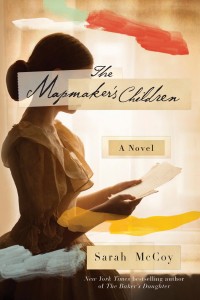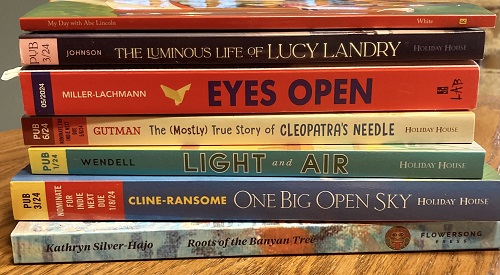Sarah McCoy Ties the Past and Present Together in The Mapmaker’s Children
JENNIFER QUINLAN
 In her newest novel, The Mapmaker’s Children, Sarah McCoy presents abolitionist John Brown through the eyes of his daughter, Sarah, and anchors the past to the present through a dual-narrative structure centered on an old house in Charlestown, West Virginia, where a doll head used to hide information for the Underground Railroad is found in the present day by a woman struggling to reconcile the life of her dreams with her current reality.
In her newest novel, The Mapmaker’s Children, Sarah McCoy presents abolitionist John Brown through the eyes of his daughter, Sarah, and anchors the past to the present through a dual-narrative structure centered on an old house in Charlestown, West Virginia, where a doll head used to hide information for the Underground Railroad is found in the present day by a woman struggling to reconcile the life of her dreams with her current reality.
McCoy explains that she originally set out to write a contemporary novel. “I heard a sentence spoken by a woman, Eden Anderson, ‘A dog is not a child.’ It was the way she said it that wouldn’t let me be. Confident, angry, and yet deeply wounded by the very words she spoke. I couldn’t shush her no matter what I did.”
In the novel, Eden struggles with infertility and the damage that years of treatments and the raised hopes and crushed dreams that accompany them can inflict on a psyche. A move to a new home in a historic small town leaves Eden feeling lonelier than ever and questioning the survival of her marriage, but the discovery of an old doll head in a hidden cellar sparks her curiosity.
As she began writing in Eden’s voice, McCoy realized that “the voice was echoing through and out the front door of an old house—the house in New Charlestown. It was calling me to solve its Underground Railroad mystery set between Eden Anderson in present-day West Virginia and Sarah Brown 150 years ago.” As Eden hunts for information on the house and the town, Sarah Brown’s story emerges in alternating chapters, revealing her connection to New Charlestown and the Underground Railroad.
McCoy visited Harper’s Ferry, the site of John Brown’s famous raid, frequently with her family as a youth, but it wasn’t until a school trip that she learned about the town’s history with the Underground Railroad. “A fascinating component quietly etched into the doorways and secret cellars all around my summer playground. I’d never noticed the signs until they were pointed out to me. And in similar fashion, it wasn’t until Eden and Sarah’s home called to me that I became completely absorbed in it.”
McCoy’s research led to the discovery of children’s toys used to smuggle information and the use of symbols, codes, and art to guide slaves and those who helped them on their way to freedom through the Underground Railroad, and it is here that McCoy discovered the heart of Sarah Brown’s story and her role in the continuation of her father’s work.
McCoy recounts how little information was available on Sarah Brown, and what was available could not be found digitally. Only by retracing Sarah’s steps in person in Massachusetts, West Virginia, and California was McCoy able to piece together Sarah’s life journey. “In my search for her, she really found me. I was wholly invested as her story archeologist. I wanted to know not merely her life trajectory, but her heart’s. So I followed her footsteps, and they imprinted themselves indelibly on my life as an author and a woman.”
When asked what prompted her to write both past and present story lines rather than a historical fiction novel about Sarah Brown, McCoy said, “I’m riveted by how the people of the past can reach across generations and impact the present; how mysteries of the present have their solutions in the past; how issues we face and decisions we make today are strikingly similar to ones our forbearers made with good and bad outcomes. I’m spellbound by this interplay—by the impact of Sarah Brown on us, the contemporary Eden Andersons of today.”
In The Mapmaker’s Children, Sarah and Eden face disappointments and struggle to accept that their lives have taken unexpected paths. But both find purpose and a renewed sense of self in helping others and in realizing that “family” doesn’t have to conform to the societal ideal. Their stories might be separated by 150 years, but their central themes of family, friendship, love, and freedom are timeless.
“Together, Sarah Brown and Eden Anderson said, You’re okay, Sarah McCoy. You’re okay, contemporary readers everywhere. We’re okay, sister women. That is how their tales work in harmony. That is their inheritance to me, and I pray to everyone who picks up this book.”
About the contributor: Jennifer Quinlan, aka Jenny Q, is an independent editor and cover designer specializing in historical fiction. Jenny studied history at Virginia Tech and copyediting at the University of California, San Diego. She writes reviews and interviews authors for her blog, Let Them Read Books, and for Romantic Historical Reviews. She also moderates the American Historical Fiction group on Goodreads. She lives in Virginia with her husband, a Civil War re-enactor and fellow history buff.







